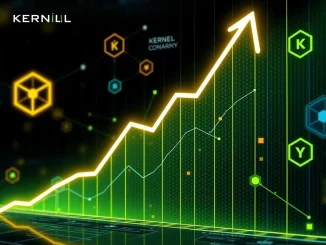
In a groundbreaking move set to redefine decentralized finance (DeFi) economics, Polymarket, the leading crypto-based prediction market platform, is actively evaluating the launch of its own native stablecoin. This strategic initiative aims to unlock significant USDC yield from its substantial reserves of Circle’s dollar-pegged stablecoin, USDC. This isn’t just about a new coin; it’s about optimizing treasury operations and pioneering new financial models within the rapidly evolving crypto landscape.
Why is Polymarket Eyeing Its Own Stablecoin?
Polymarket’s decision stems from a desire to maximize the utility of its substantial USDC holdings. Currently, these reserves, crucial for facilitating prediction market trades, largely remain idle and unproductive. The platform’s internal discussions highlight two primary pathways to generate passive income:
- Proprietary Stablecoin Launch: By creating its own Polymarket stablecoin, the platform could deploy these assets into various DeFi lending protocols or other yield-generating strategies. This would allow Polymarket to directly capture the returns that typically accrue to external stablecoin issuers.
- Revenue-Sharing with Circle: Alternatively, Polymarket could negotiate a revenue-sharing agreement with Circle. This model, adopted by some traditional fintech platforms, would allow Polymarket to benefit from the profits Circle generates by investing its USDC reserves, leveraging an established infrastructure without the full burden of stablecoin issuance.
This strategic shift reflects a broader industry trend where platforms seek to reduce reliance on third-party partners and enhance their financial efficiency. For a prominent prediction market like Polymarket, this could unlock substantial new revenue streams.
Unlocking DeFi Yield: The Core Motivation
The pursuit of DeFi yield is a powerful driver in the current crypto ecosystem. As demand for yield-generating mechanisms continues to surge, Polymarket’s move aligns perfectly with the broader decentralized finance narrative. Their existing USDC reserves, while essential for liquidity, represent a significant untapped asset. By transforming these idle funds into active, income-generating capital, Polymarket aims to:
- Boost Treasury Operations: Convert unproductive assets into a continuous stream of passive income.
- Enhance Financial Autonomy: Reduce dependency on external stablecoin issuers and their operational models.
- Improve User Experience: Potentially lead to lower trading fees or increased rewards for users, creating a more attractive ecosystem.
The potential for Polymarket to retain the yield from its reserves could fundamentally redefine the economic dynamics within blockchain-based financial services.
Navigating the Landscape of Crypto Stablecoin Innovation
While the prospect of a native crypto stablecoin offers significant advantages, it also comes with inherent challenges. Launching a new stablecoin requires meticulous planning and execution, particularly concerning:
- Trust and Adoption: Building user confidence and achieving widespread adoption for a new stablecoin in a competitive market.
- Liquidity Management: Ensuring sufficient liquidity to maintain the peg and support smooth trading operations.
- Regulatory Compliance: Navigating complex and evolving regulatory frameworks, particularly in the U.S. market. A partnership with Circle could mitigate some of these risks by leveraging an already established and compliant infrastructure.
The U.S. regulatory landscape has seen recent federal legislation providing a clearer legal framework for stablecoin issuance, which could provide a more stable environment for Polymarket’s ambitions.
Polymarket’s Momentum: A Billion-Dollar Prediction Market
Polymarket’s exploration of these yield-generating strategies comes at a time of immense growth and market validation. The platform’s valuation now exceeds an impressive $1 billion, underscored by its significant operational achievements:
- Trading Volume: Over $8 billion in trading volume during the high-stakes 2024 U.S. election cycle, demonstrating robust user engagement and market activity.
- Website Traffic: More than 15 million website visits in May 2025, indicating a strong and growing user base.
Furthermore, Polymarket is actively advancing plans to expand its U.S. presence, including the proposed acquisition of QCEX, contingent on resolving past regulatory hurdles. This expansion underscores their commitment to growth and market dominance, making the optimization of USDC yield even more critical for long-term sustainability.
While no final decision has been made, the strategic advantages of either a native stablecoin or a robust revenue-sharing model are clear. Success will hinge on effectively navigating compliance requirements, fostering user adoption, and maintaining competitiveness in a rapidly evolving market. Polymarket’s bold consideration of these options signals a significant step towards a more financially autonomous and efficient future for decentralized prediction markets.
Frequently Asked Questions (FAQs)
1. What is Polymarket considering to generate yield from its USDC reserves?
Polymarket is reportedly evaluating two main strategies: launching its own proprietary stablecoin or negotiating a revenue-sharing agreement with Circle, the issuer of USDC.
2. Why is Polymarket interested in generating yield from USDC?
Currently, Polymarket’s USDC reserves, used for facilitating prediction market trades, are idle. By generating yield, Polymarket aims to optimize its treasury operations, create passive income, and enhance financial efficiency within its platform.
3. What are the potential benefits for Polymarket users if a stablecoin is launched or a partnership is formed?
For users, this development could potentially lead to improved liquidity within the platform, lower trading fees, or even increased rewards, making the prediction market experience more attractive.
4. What are the main challenges associated with Polymarket launching its own stablecoin?
Key challenges include building user trust and achieving widespread adoption, effectively managing liquidity to maintain the stablecoin’s peg, and navigating the complex and evolving regulatory compliance landscape, especially in the U.S.
5. How has the U.S. regulatory environment influenced Polymarket’s decision?
Recent federal legislation in the U.S. has provided a clearer legal framework for stablecoin issuance. This evolving regulatory landscape offers a more supportive environment for initiatives like Polymarket’s exploration of a native stablecoin or a partnership model.



